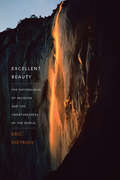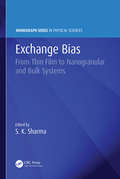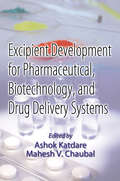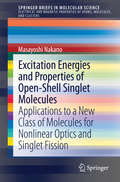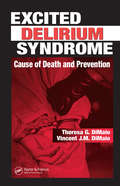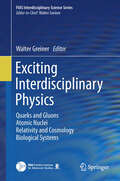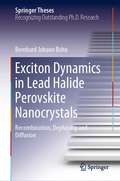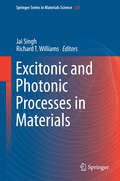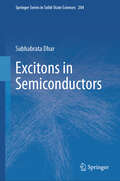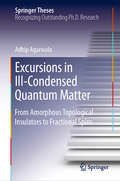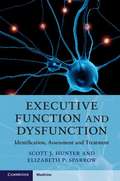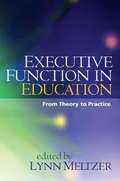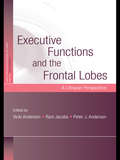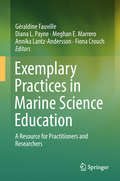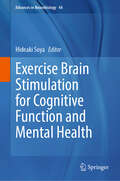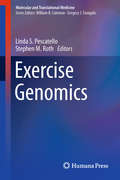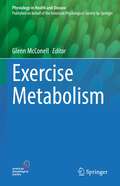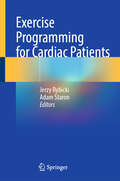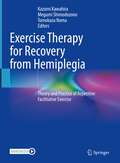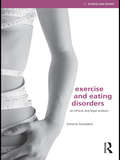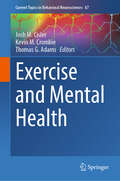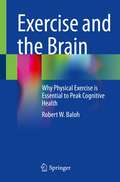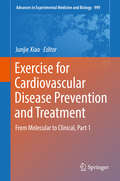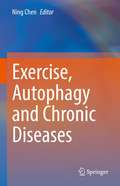- Table View
- List View
Excellent Beauty: The Naturalness of Religion and the Unnaturalness of the World
by Eric DietrichFlipping convention on its head, Eric Dietrich argues that science uncovers awe-inspiring, enduring mysteries, while religion, regarded as the source for such mysteries, is a biological phenomenon. Just like spoken language, Dietrich shows that religion is an evolutionary adaptation. Science is the source of perplexing yet beautiful mysteries, however natural the search for answers may be to human existence.Excellent Beauty undoes our misconception of scientific inquiry as an executioner of beauty, making the case that science has won the battle with religion so thoroughly it can now explain why religion persists. The book also draws deep lessons for human flourishing from the very existence of scientific mysteries. It is these latter wonderful, completely public truths that constitute some strangeness in the proportion, revealing a universe worthy of awe and wonder.
Exchange Bias: From Thin Film to Nanogranular and Bulk Systems (Monograph Series in Physical Sciences)
by Surender Kumar SharmaThis timely book covers basic mechanisms, characterization, theoretical simulations, and applications for exchange bias in granular nanosystems, thin films, and bulk systems. After an overview of the field and key principles, the next section covers nanogranular (core-shell) systems, followed by chapters on thin films, bilayers/multilayers nanostructures, dilute magnetic semiconductors, and multiferroic systems. A final section turns to bulk systems, such as those consisting of perovskite structures, rare earth-transition metal intermetallic, and ion implantations. Readers of this book will obtain A complete, modern overview on exchange bias phenomena, covering synthesis, characterization techniques, and applications An introduction to all the important phenomenological models proposed for thin films, bulk materials, and nanoparticles Detailed discussion of the importance of size, shape, cooling field, and temperature on exchange bias properties Understanding of novel applications of exchange bias systems
Excipient Development for Pharmaceutical, Biotechnology, and Drug Delivery Systems
by Ashok Katdare Mahesh V. ChaubalTo facilitate the development of novel drug delivery systems and biotechnology-oriented drugs, the need for new, yet to be developed, and approved excipients continues to increase. Excipient Development for Pharmaceutical, Biotechnology, and Drug Delivery Systems serves as a comprehensive source to improve understanding of excipients and forge potential new avenues for regulatory approval. This book presents detailed, up-to-date information on various aspects of excipient development, testing, and technological considerations for their use. It addresses specific details such as historical perspective, preclinical testing, safety, and toxicology evaluation, as well as regulatory, quality, and utility aspects. The text also describes best practices for use of various functional excipients and extensive literature references for all topics.
Excitation Energies and Properties of Open-Shell Singlet Molecules
by Masayoshi NakanoThis brief investigates the diradical character, which is one of the ground-state chemical indices for "bond weakness" or "electron correlation" and which allows researchers to explore the origins of the electron-correlation-driven physico-chemical phenomena concerned with electronic, optical and magnetic properties as well as to control them in the broad fields of physics and chemistry. It then provides the theoretical fundamentals of ground and excited electronic structures of symmetric and asymmetric open-shell molecular systems by using model molecular systems. Moreover, it presents the theoretical design guidelines for a new class of open-shell singlet molecular systems for nonlinear optics (NLO) and singlet fission.
Excited Delirium Syndrome: Cause of Death and Prevention
by Theresa G. DiMaio Vincent J.M. DiMaio M.D.During a routine investigation, a suspect turns hostile. The officers on the scene spring into action and get the suspect� under control by handcuffing him. Though the suspect has been successfully subdued � he dies shortly thereafter� A psychiatric patient suddenly becomes violent. The hospital staff struggles to control the patient
Excited Delirium Syndrome: Cause of Death and Prevention
by Theresa G. DiMaio Vincent J.M. DiMaio M.D.During a routine investigation, a suspect turns hostile. The officers on the scene spring into action and get the suspect� under control by handcuffing him. Though the suspect has been successfully subdued � he dies shortly thereafter� A psychiatric patient suddenly becomes violent. The hospital staff struggles to control the patient
Exciting Interdisciplinary Physics
by Walter GreinerNuclear physics is an exciting, broadly faceted field. It spans a wide range of topics, reaching from nuclear structure physics to high-energy physics, astrophysics and medical physics (heavy ion tumor therapy). New developments are presented in this volume and the status of research is reviewed. A major focus is put on nuclear structure physics, dealing with superheavy elements and with various forms of exotic nuclei: strange nuclei, very neutron rich nuclei, nuclei of antimatter. Also quantum electrodynamics of strong fields is addressed, which is linked to the occurrence of giant nuclear systems in, e.g., U+U collisions. At high energies nuclear physics joins with elementary particle physics. Various chapters address the theory of elementary matter at high densities and temperature, in particular the quark gluon plasma which is predicted by quantum chromodynamics (QCD) to occur in high-energy heavy ion collisions. In the field of nuclear astrophysics, the properties of neutron stars and quark stars are discussed. A topic which transcends nuclear physics is discussed in two chapters: The proposed pseudo-complex extension of Einstein's General Relativity leads to the prediction that there are no black holes and that big bang cosmology has to be revised. Finally, the interdisciplinary nature of this volume is further accentuated by chapters on protein folding and on magnetoreception in birds and many other animals.
Exciton Dynamics in Lead Halide Perovskite Nanocrystals: Recombination, Dephasing and Diffusion (Springer Theses)
by Bernhard Johann BohnLess than a decade ago, lead halide perovskite semiconductors caused a sensation: Solar cells exhibiting astonishingly high levels of efficiency. Recently, it became possible to synthesize nanocrystals of this material as well. Interestingly; simply by controlling the size and shape of these crystals, new aspects of this material literally came to light. These nanocrystals have proven to be interesting candidates for light emission. In this thesis, the recombination, dephasing and diffusion of excitons in perovskite nanocrystals is investigated using time-resolved spectroscopy. All these dynamic processes have a direct impact on the light-emitting device performance from a technology point of view. However, most importantly, the insights gained from the measurements allowed the author to modify the nanocrystals such that they emitted with an unprecedented quantum yield in the blue spectral range, resulting in the successful implementation of this material as the active layer in an LED. This represents a technological breakthrough, because efficient perovskite light emitters in this wavelength range did not exist before.
Excitonic and Photonic Processes in Materials
by Jai Singh Richard T. WilliamsThis book is expected to present state-of-the-art understanding of a selection of excitonic and photonic processes in useful materials from semiconductors to insulators to metal/insulator nanocomposites, both inorganic and organic. Among the featured applications are components of solar cells, detectors, light-emitting devices, scintillators and materials with novel optical properties. Excitonic properties are particularly important in organic photovoltaics and light emitting devices, as also in questions of the ultimate resolution and efficiency of new-generation scintillators for medical diagnostics, border security and nuclear non proliferation. Novel photonic and optoelectronic applications benefit from new material combinations and structures to be discussed.
Excitons in Semiconductors (Springer Series in Solid-State Sciences #204)
by Subhabrata DharThis book explores fundamental and experimental aspects of excitons in semiconductors. It begins with an introduction to crystal lattice, band structure of solids, effective mass theory, and holes. It then explores the binding energy of various excitons and their complexes (such as trions and biexcitons) in different dimensions within the framework of effective mass approximation, discusses the absorption and emission of photons during their creation and recombination processes providing experimental examples in photo-absorption and photoluminescence (PL) spectroscopy. Theoretical foundations for calculating the dielectric function associated with excitons along with the concept of 'exciton-polaritons' are introduced. The book also examines the interaction between excitons and phonons, which is illustrated with experimental findings. Further, it discusses the effects of magnetic field on the energy eigenstates of excitons, and talks about polarization-resolved spectroscopy under magnetic field for identifying excitons and obtaining deeper insight of the excitonic structure as well as the semiconductor band structure. Lastly, it delves into the manybody effects i.e. Bose-Einstein condensation of excitons and excitonic Mott transition, presenting recent experimental findings and potential applications. Throughout, emphasis is placed on elucidating fundamental concepts while keeping readers abreast of the latest developments in the field. With a focus on experimental methods and data interpretation, the book serves as an invaluable resource for both graduate students and research scholars.
Excursions in Ill-Condensed Quantum Matter: From Amorphous Topological Insulators to Fractional Spins (Springer Theses)
by Adhip AgarwalaImpurities, disorder or amorphous systems – ill-condensed matter – are mostly considered inconveniences in the study of materials, which is otherwise heavily based on idealized perfect crystals. The Kondo effect and the scaling theory of localization are among the fundamental and early discoveries which revealed the novelty hidden in impure or disordered systems. Recent advances in condensed matter physics have emphasized the role of topology, spin-orbit coupling, and certain discrete symmetries such as time reversal in many physical phenomena. These have irreversibly transformed the essential ideas and purview of condensed matter physics, both in theoretical and experimental directions. However, many of these recent developments and their implications are limited to, or by, ideas that pertain to clean systems. This thesis deals with various aspects of these new developments, but in the case of unclean systems. The author introduces new ideas such as amorphous topological insulators, fractalized metals and fractionalized spins.
Executive Function and Dysfunction
by Scott J. Hunter Elizabeth P. SparrowExecutive dysfunction occurs in many clinical conditions and has significant impact on multiple facets of life. This book summarizes executive function and dysfunction for practitioners, researchers and educators, covering lifespan development, assessment, impact and interventions. Drawing together clinical, neurobiological and developmental viewpoints, the authors summarize the latest research findings in practical and applied terms, and review conceptual approaches to assessing and identifying executive function and dysfunction. Several chapters are devoted to practical aspects of executive dysfunction, including research-based treatment strategies, educational implications, forensic cautions and intervention resources. Executive dysfunction in ADHD, LD, MR, autism, mood disorders, epilepsy, cancer and TBI is covered, with test performance, neuroimaging and clinical presentation for these clinical conditions. The book concludes with anticipation of future work in the field. This is a key reference for medical, psychological and educational professionals who work with children, adolescents and young adults in clinical and educational settings.
Executive Function in Education
by Lynn MeltzerThis uniquely integrative book brings together research on executive function processes from leaders in education, neuroscience, and psychology. It focuses on how to apply current knowledge to assessment and instruction with diverse learners, including typically developing children and those with learning difficulties and developmental disabilities. The role of executive function processes in learning is examined and methods for identifying executive function difficulties are reviewed. Chapters describe scientifically grounded models for promoting these key cognitive capacities at the level of the individual child, the classroom, and the entire school. Implications for teaching particular content areas reading, writing, and math are also discussed.
Executive Functions and the Frontal Lobes: A Lifespan Perspective (Studies on Neuropsychology, Neurology and Cognition)
by Vicki AndersonThis volume has as its primary aim the examination of issues concerning executive function and frontal lobe development. While many texts have addressed these issues, this is the first to do so within a specifically developmental framework. This area of cognitive function has received increasing attention over the past decade, and it is now established that the frontal lobes, and associated executive functions, are critical for efficient functioning in daily life. It is also clear, and of particular relevance to this text, that these functions develop gradually through childhood, and then deteriorate during old age. These developmental trajectories, and the impact of any interruption to them, are the focus of this volume.
Exemplary Practices in Marine Science Education: A Resource for Practitioners and Researchers
by Géraldine Fauville Diana L. Payne Meghan E. Marrero Annika Lantz-Andersson Fiona CrouchThis edited volume is the premier book dedicated exclusively to marine science education and improving ocean literacy, aiming to showcase exemplary practices in marine science education and educational research in this field on a global scale. It informs, inspires, and provides an intellectual forum for practitioners and researchers in this particular context. Subject areas include sections on marine science education in formal, informal and community settings. This book will be useful to marine science education practitioners (e.g. formal and informal educators) and researchers (both education and science).
Exercise Brain Stimulation for Cognitive Function and Mental Health (Advances in Neurobiology #44)
by Hideaki SoyaThis book provides compelling evidence on the beneficial effects of aerobic exercise on the brain, focusing on the prefrontal cortex and hippocampus, which are crucial for cognitive and memory functions. Organized into three major themes, it offers a comprehensive exploration of translational research from animals to humans, the interaction between the brain and peripheral organs, and advanced methodologies for understanding exercise's impact on brain health. These themes collectively offer a systematic exploration of exercise's impact on brain health, integrating the latest scientific insights from both animal and human studies. The chapters delve into key concepts such as the role of myokines and hepatokines in mediating exercise's effects on the brain, the neuroprotective potential of physical activity, and its application as a therapeutic intervention for neuropsychiatric conditions like Alzheimer's disease and depression. By bridging basic and applied knowledge, this book provides a cohesive framework for understanding how exercise influences brain structure, function, and neurochemical pathways. It also introduces novel methodologies and modulatory factors that may enhance or contextualize these effects, offering a critical synthesis of a rapidly evolving field. This volume is an invaluable resource for researchers, clinicians, educators, and students in neuroscience, physiology, and psychiatry. It serves as both a reference and a catalyst for further research and practical applications, encouraging a shift in how we conceptualize exercise: not merely as a component of good health, but as a dynamic modulator of brain function. By providing a detailed understanding of the mechanisms underlying exercise's effects on the brain, this book invites readers to explore the potential of physical activity as a non-pharmacological tool for supporting cognitive and emotional well-being.
Exercise Genomics
by Linda S. Pescatello Stephen M. RothExercise Genomics encompasses the translation of exercise genomics into preventive medicine by presenting a broad overview of the rapidly expanding research examining the role of genetics and genomics within the areas of exercise performance and health-related physical activity. Leading researchers from a number of the key exercise genomics research groups around the world have been brought together to provide updates and analysis on the key discoveries of the past decade, as well as lend insights and opinion about the future of exercise genomics, especially within the contexts of translational and personalized medicine. Clinicians, researchers and health/fitness professionals will gain up-to-date background on the key findings and critical unanswered questions across several areas of exercise genomics, including performance, body composition, metabolism, and cardiovascular disease risk factors. Importantly, basic information on genomics, research methods, and statistics are presented within the context of exercise science to provide students and professionals with the foundation from which to fully engage with the more detailed chapters covering specific traits. Exercise Genomics will be of great value to health/fitness professionals and graduate students in kinesiology, public health and sports medicine desiring to learn more about the translation of exercise genomics into preventive medicine.
Exercise Metabolism (Physiology in Health and Disease)
by Glenn McConellIn this Edited Volume, a diverse group of exercise metabolism experts, assembled a multi-facetted collection of fascinating contributions. The chapters focus on metabolism during exercise, including anaerobic and aerobic metabolism, carbohydrate metabolism (separate chapters on muscle glycogen and blood glucose), fat metabolism (separate chapters on muscle and adipose tissue) and protein metabolism. Readers will find discussion on various tissues in addition to skeletal muscle, such as liver, heart and brain metabolism during exercise. In addition, the book includes chapters on other perspectives such as thermodynamic and bioenergetic aspects of exercise and a dive into history. Another focal point is on the effects of exercise in relation to training, age, sex, fatigue and the circadian rhythm. This contemporary collection will be an essential resource for Physiologists, Sports Scientists, Coaches, Athletes and students alike.
Exercise Programming for Cardiac Patients
by Jerzy Rybicki Adam StaronThis book demonstrates the principle of exercise testing and training, describing in precise and technical detail the use of exercise prescription to support the management of cardiac patients. It comprehensively reviews all available solutions for exercise testing with appropriate consideration of optimal testing conditions, especially when more rigorous cardiopulmonary testing is unavailable. Translation of testing results into exercise training parameters should follow specific rules, and the authors present their approach and the development of specific tools to assist, such as instant exercise intensity calculators or interval-to-continuous approach with flexible progression rate based on heart rate plateau. Predicted training intensity and adequate training progression remain key elements of successful exercise prescription. Finally, this book describes how an exercise prescription follow-up program will determine long-term outcome. Based on the authors' educational workshops, Exercise Programming for Cardiac Patients encourages a prescriptive approach to exercise training with dosage, up-titration and comprehensive overview of patient parameters. As a critical preventative concept, exercise training is often overlooked, but this book is formulated to provide extensive supportive information for cardiologists looking to include it into their patients' management regimens. It is therefore designed to promote the clinical application of exercise training and is a key addition to the literature for all involved in the management of these patients.
Exercise Therapy for Recovery from Hemiplegia: Theory and Practice of Repetitive Facilitative Exercise
by Kazumi Kawahira Megumi Shimodozono Tomokazu NomaThis book introduces an innovative, efficient, and patient-friendly neural net constructive therapy for patients with mild to severe hemiplegia, not only in the recovery phase but also in acute and chronic phases. The explanations are supported by extensive photographs of each position and a set of 72 video clips to help readers follow and reproduce the techniques. This book explains the theory of Repetitive Facilitative Exercise (RFE), which is a combination of repetitive volitional flexion and extension movements from neurofacilitation approaches. This exercise is aimed at achieving the intended movements and lessening synergistic movement patterns by reconstructing and strengthening the neuropathways of the injured nerve tract. Instead of interpreting disorders based on reflex theory and constructing treatment methods, the new approach considers scientific treatment methods that emphasize the formation of neural pathways by improving synapse formation and transmission efficiency based on functional localization, central programs, and neural nets. Chapters provide a basic theory of RFE, offering the underlying mechanisms of nerve tract formation/strengthening, such as functional localization, voluntary movement, plasticity, and neural lateral sprouting, giving readers a comprehensive understanding of the prompt and repetitive therapy. This is followed by an exposition of practice and techniques, planning of treatment programs, and facilitation techniques for voluntary movements of the upper limb, individual fingers, and lower limb. Finally, the book introduces RFE to facilitate and enhance motor skills in walking and other functions. Exercise Therapy for Recovery from Hemiplegia - Theory and Practice of Repetitive Facilitative Exercise will provide rehabilitation therapists, physiotherapists, occupational therapists, and medical doctors a refreshing alternative theory and practice to current approaches. Neuroscience researchers, stroke patients, and their families would find this book informative.
Exercise and Eating Disorders: An Ethical and Legal Analysis (Ethics and Sport)
by Simona GiordanoEating disorders (EDs) have become a social epidemic in the developed world. This book addresses the close links between EDs and exercise, helping us to understand why people with EDs often exercise to excessive and potentially harmful levels. This is also the first book to examine this issue from an ethical and legal perspective, identifying the rights and responsibilities of people with EDs, their families and the fitness professionals and clinicians that work with them. The book offers an accessible account of EDs and closely examines the concept of addiction. Drawing on a wide range of medical, psychological, physiological, sociological and philosophical sources, the book examines the benefits and risks of exercise for the ED population, explores the links between EDs and other abuses of the body in the sports environment and addresses the issue of athletes with disordered eating behaviour. Importantly, the book also surveys current legislation and professional codes of conduct that guide the work of fitness professionals and clinicians in this area and presents a clear and thorough set of case histories and action points to help professionals better understand, and care for, their clients with EDs. Exercise and Eating Disorders is important reading for students of applied ethics, medical ethics and the ethics of sport, as well as for fitness professionals, psychiatrists, clinical psychologists, sports coaches and sport and exercise scientists looking to improve their understanding of this important issue.
Exercise and Mental Health (Current Topics in Behavioral Neurosciences #67)
by Josh M. Cisler Kevin M. Crombie Thomas G. AdamsThis edited volume describes key domains of the emerging research literature linking exercise and mental health. The volume is divided into three sections. The first section provides an overview of foundational knowledge regarding basic processes of exercise, including neurocircuitry, neurotransmitter, and immunology systems. The second section describes emerging research on the acute impact of exercise on affect, mood, and cognition. The third section explores the role of exercise in the etiology and treatment of related mental and physical health disorders, including depression, PTSD, eating disorders, and autoimmune disorders. Collectively, this volume provides readers with foundational knowledge of what exercise is, the basic brain, behavioral and cognitive processes engaged by exercise, and a role of exercise in developing and treating mental health disorders.
Exercise and the Brain: Why Physical Exercise is Essential to Peak Cognitive Health
by Robert W. BalohThis book focuses on the benefits of exercise for prevention and treatment of chronic brain disorders. It is a guide for finding the right exercise routine for each individual. The goal is to show the reader why everyone needs to exercise, especially as we get older. The brain needs physical exercise both for normal health and for preventing and treating diseases common with aging.How much exercise is needed? As we see throughout the book there is no one fits all rule with regard to the amount of exercise required. The key is to make exercise a part of one’s daily routine. The beneficial effect of exercise is transient, lasting days to weeks, so it must be a lifelong pursuit. Can we exercise too much? Anything done in excess can potentially be dangerous but with the common sense approach outlined in this book anyone, regardless of underlying health condition, can find some type of exercise that is safe and effective.
Exercise for Cardiovascular Disease Prevention and Treatment
by Junjie XiaoThe book provides an intensive overview on exercise for cardiovascular disease prevention and treatment, from basic research to clinical practice. The volume first summarizes the acute and chronic response to exercise. Second, evidence for exercise as medicine for the heart based on clinical studies and basic research is summarized. Third, molecular mechanisms mediating the beneficial effects of exercise including IGF-1-PI3K-AKT signalling, NO signalling, C/EBPB-Cited4 signalling, Non-coding RNAs, epigenetic regulators, mitochondria adaption and exosomes are presented. Finally, exercise dosing, prescription and future prospects are provided. This book will provide valuable reference for researchers in cell biology, physiology, as well as physician, physical therapist in cardiology, sport medicine, etc.
Exercise, Autophagy and Chronic Diseases
by Ning ChenThis book establishes a bridge between exercise-mediated functional status of autophagy and non-communicable chronic diseases for elucidating and clarifying the corresponding signal pathways and underlying mechanisms. The book consists of 13 chapters focusing on the in-depth discussion on signal pathways for regulating the functional status of autophagy for the prevention, treatment and rehabilitation of chronic diseases, the optimization of exercise intervention strategies for common and frequently-occurring chronic diseases, and the development of exercise mimetic pills for the persons with disability for exercise performance, or the persons without willing to exercise. This book is interesting and will be useful to a wide readership in the various fields of exercise science, exercise fitness, sports medicine, preventive medicine, and functional foods.
